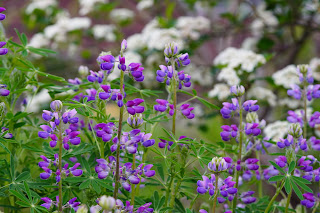"Wildflowers can’t be controlled, and neither can the girl with a soul boundless as the sky, and a spirit as free and wild as the ocean"
Melody Lee
I have this wall calendar with a bunch of folklore from the farmers almanac hanging in the kitchen, near the toaster oven. Last month's entry talked about the dogwood winter, must be mostly an eastern thing as I have seen a lot of references to the Tennessee mountains regarding this phenomenon. The legends say that the dogwood winter is when the Cornus start blooming and northern cold fronts push in to give the little winters in the middle of spring. I've never heard it referenced here in Oregon where the lovely Cornus nutallii dots the woods. I think we are experiencing the opposite of a dogwood winter this season. The dogwood summer came on about 3 weeks ago when we hit 80 degrees in April. Normally, you can count on April to produce pretty much non stop rain showers, broken only by the occasional gale and often a downpour to mix it up. If we are really lucky a day might start with drizzle, a few sunbreaks will find shorts and sun dresses on the streets only for the day to end with a thunderstorm and a half inch of rain. Not this year. This spring has been crazy dry, when it stopped raining three weeks ago I thought, this is a nice little break from the usual April dreary grey skies, but then the warmth pushed a lot of the spring bulbs over way to fast and pretty soon the clay soil for which the valley is so famous was starting to crack from the lack of moisture.
I don't know what a Dogwood Summer heralds for the rest of the growing season, but I sure hope it doesn't mean an inferno of a summer.
The Camas collection is starting to bloom, as are many of the May wildflowers of the Willamette valley.
William Conklin Cusick is a name that should be familiar to anyone who studies the flora of Oregon. A self taught botanist in the likes of Howell and Suskdorf. He was assigned to monitor the activities of the Nez Peirce tribe in Idaho as a volunteer of the union army during the Civil War. The Nez Peirce were peaceful and this left Cusick plenty of time to botanize in the hills around Fort Lapwai. Following the war he spent time in Sisters, Oregon and Salem, before finally establishing a homestead in the Thief Valley, near the Powder River of Eastern Oregon. Asa Gray got him into the real deal of botanical collection and he was soon making expeditions into the Cornucopia area of the Wallowa Mountains, from which the form of his namesake Camas was likely seen. One of the interesting pieces of his story that jumped out to me was he married a widow with 8 children later in life, he supported two of the boys as they attended the Oregon Agricultural College (later to become my alma mater Oregon State University). Both of the boys dropped out of college to get married. I wonder how dissapointed he was at that?
 |
| The indomitable Camas cusickii from a seed collection many years ago in Oregon's Wallowa mountains just seems to get better with age. |
 |
| Lupines and Hawthornes as the Wildflower bloom commences. |
 |
| Nelsons Checkermallow in the Wildflower meadow at Illahe |
 |
| Iris douglasiana in the flower border |















No comments:
Post a Comment
Note: Only a member of this blog may post a comment.